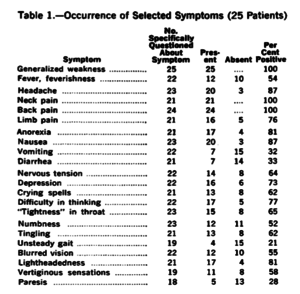1961 New York State outbreak
An outbreak in a convent in New York affected 26 of 69 nuns.[1] The first case had onset in July, 1961, the last in January, 1962.
Symptoms[edit | edit source]

- fatigue
- weakness
- low-grade fever
- nausea
- headache
- pain in neck, trunk or limbs
- emotional instability
- depression
- impaired thinking
- blurred vision
- localized weakness, muscular twitching and paresthesias
Findings[edit | edit source]
- low-grade fever
- elevated spinal fluid cell counts,
- high lymphocyte count in the peripheral blood
- elevated erythrocyte sedimentation rate
- increased urinary creatine excretion during periods of exacerbations (creatine was high high during relapses and normal during periods of recovery)
Epidemiology[edit | edit source]
The convent was largely isolated from contact with the outside world. Thirty-eight percent became ill, with younger nuns more commonly affected. Of nuns under age 30, 57% were affected as compared to 7% of nuns over age 30. None of the elderly nuns (age 65 up) who resided in the "infirmary" and had very little contact with younger nuns were affected. [1]
Course & prognosis[edit | edit source]
"The illness lasted for weeks or months and characteristically was marked by remissions and relapses. Many convalescent patients were forced to take to bed and had exacerbations at the time of their menstrual periods or when they attempted to return to normal activity."[1]
Thirteen months after onset of the first case, 12 patients remaining in the convent were examined using functional muscle testing developed for the 1954 trial of poliomyelitis vaccine, only one was completely normal. 11 had scattered weakness of a mild degree. By June, 1962, one year after onset of the epidemic, 9 nuns had recovered, 1 had almost recovered, 13 were still ill, and 3 had transferred elsewhere.
See also[edit | edit source]
- Epidemic myalgic encephalomyelitis
- List of myalgic encephalomyelitis and chronic fatigue syndrome outbreaks
References[edit | edit source]
- ↑ 1.0 1.1 1.2 1.3 Albrecht, Robert (March 21, 1964). "Epidemic Neuromyasthenia Outbreak in a Convent in New York State". Journal of the American Medical Association. 187: 904–907.

